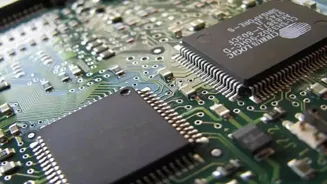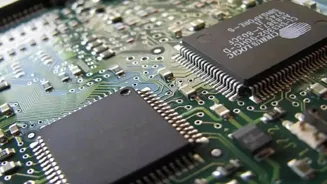What is the story about?
In his 12th consecutive Independence Day speech, Prime Minister Narendra Modi said that the government is working on self-reliance in technology on 'mission mode' and the first chip, entirely made in India, would hit the
market before the year ends.
Currently, Taiwan, South Korea, Japan, the United States, and China are the world's biggest semiconductor manufacturing countries. China and Taiwan reportedly account for 75% of all the chips in the world.
Since the inception of the Semiconductor Mission in 2022, with an outlay of ₹76,000 crore, India has invited foreign investments and encouraged the development of indigenous semiconductor plants.
India has approved six semiconductor chip manufacturing plants. The latest of the
six was approved in May 2025, to be set up in Jewar in Uttar Pradesh. Four other plants are in Gujarat and one is in Assam.
On August 4, the Union Cabinet approved four semiconductor projects in Odisha, Punjab and Andhra Pradesh.
Government support and incentives
50% fiscal support for eligible projects under the modified semiconductor ecosystem development scheme.
Design-linked incentive (DLI) scheme, which supports semiconductor startups and R&D initiatives.
State-level subsidies, with states
offering additional incentives ranging from 10-25% over and above the central government grants.
The recent trade tensions and tariff wars have revealed the leverage enjoyed by countries that have a lead in chip manufacturing or rare earth minerals refining capacity, which are crucial to drive innovation in artificial intelligence.
Like India, countries like Mexico and Malaysia are also spending billions to design and manufacture chips.
Currently, Taiwan, South Korea, Japan, the United States, and China are the world's biggest semiconductor manufacturing countries. China and Taiwan reportedly account for 75% of all the chips in the world.
Since the inception of the Semiconductor Mission in 2022, with an outlay of ₹76,000 crore, India has invited foreign investments and encouraged the development of indigenous semiconductor plants.
India has approved six semiconductor chip manufacturing plants. The latest of the
On August 4, the Union Cabinet approved four semiconductor projects in Odisha, Punjab and Andhra Pradesh.
Government support and incentives
50% fiscal support for eligible projects under the modified semiconductor ecosystem development scheme.
Design-linked incentive (DLI) scheme, which supports semiconductor startups and R&D initiatives.
State-level subsidies, with states
The recent trade tensions and tariff wars have revealed the leverage enjoyed by countries that have a lead in chip manufacturing or rare earth minerals refining capacity, which are crucial to drive innovation in artificial intelligence.
Like India, countries like Mexico and Malaysia are also spending billions to design and manufacture chips.
Do you find this article useful?

















